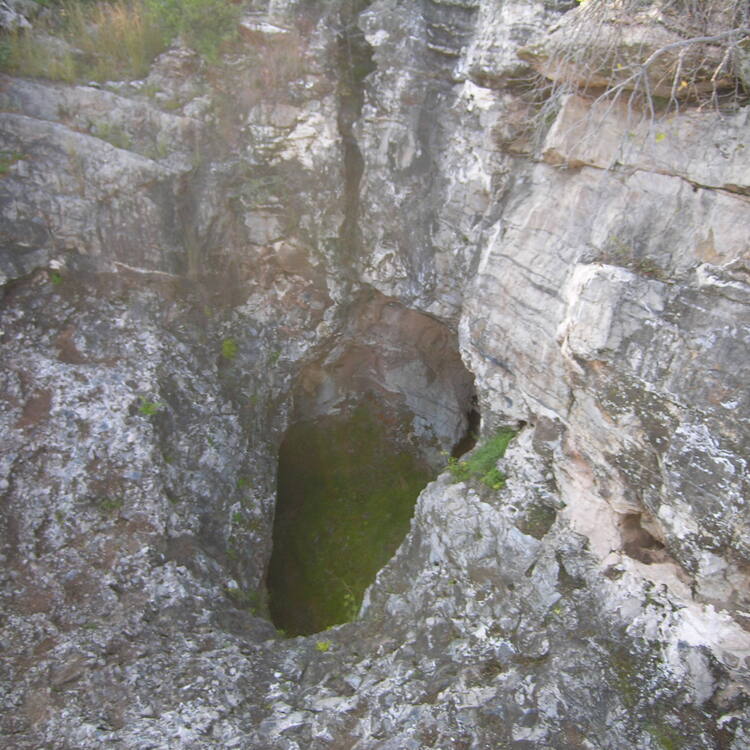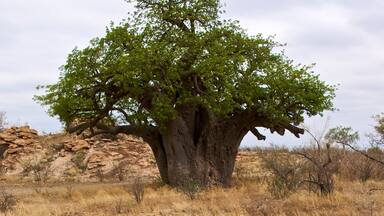Fossil Hominid Sites of South Africa
Fossil Hominid Sites of South Africa
The Taung Skull Fossil Site, part of the extension to the site inscribed in 1999, is the place where in 1924 the celebrated Taung Skull – a specimen of the species Australopithecus africanus – was found. Makapan Valley, also in the site, features in its many archaeological caves traces of human occupation and evolution dating back some 3.3 million years. The area contains essential elements that define the origin and evolution of humanity. Fossils found there have enabled the identification of several specimens of early hominids, more particularly of Paranthropus, dating back between 4.5 million and 2.5 million years, as well as evidence of the domestication of fire 1.8 million to 1 million years ago.
Description is available under license CC-BY-SA IGO 3.0
Sites des hominidés fossiles d’Afrique du Sud
C’est sur ce site que le célèbre crâne fossile de Taung – un spécimen de l’espèce Australopithecus africanus – fut découvert en 1924. La vallée de Makapan, elle aussi sur ce site, abrite dans ses nombreuses grottes archéologiques des traces d’occupation et d’évolution humaines remontant à quelque 3,3 millions d’années. L’ensemble de la région contient des éléments essentiels définissant l’origine et l’évolution de l’humanité. Les fossiles trouvés ont permis l’identification de plusieurs spécimens des premiers hominidés, plus particulièrement du Paranthropus, vieux de 2,5 à 4,5 millions d’années, ainsi que des preuves de la domestication du feu il y a 1,8 million à 1 million d’années. Il s’agit d’une extension du site inscrit en 1999.
Description is available under license CC-BY-SA IGO 3.0
موقع الهومنيدات (متحجّرات الإنسان البدائي) في ستيركفونتين وسوارتكرانس وكرومدراي وأنفيرون
في هذا الموقع بالذات، تم اكتشاف جمجمة تونغ المتحجّرة وهي نموذج عن الأوسترالوبيتيكوس أفريكنوس (الإنسان البدائي) في العام 1924. ويضم وادي ماكابان الواقع هو أيضاً على هذا الموقع بمغاوره الأثرية المتعددة آثار استقرار وتطوّر بشريين ترقى إلى حوالى 3.3 مليون سنة. وتشمل المنطقة عناصر أساسية تحدّد مصدر البشرية وتطوّرها. وقد سمحت المتحجّرات التي تمّ اكتشافها بالتعرّف إلى عدد كبير من النماذج البشريّة الأولى وبشكل خاص البارانتروبوس الذي تعود جذوره إلى حوالى 2.5 إلى 4.5 مليون سنة، بالإضافة إلى براهين عن سيطرة الإنسان على النار قبل 1.8 إلى 1 مليون سنة. يشكّل هذا الموقع امتداداً لموقع مسجّل في العام 1999.
source: UNESCO/CPE
Description is available under license CC-BY-SA IGO 3.0
斯泰克方丹、 斯瓦特科兰斯、 科罗姆德拉伊和维罗恩斯的化石遗址
汤恩头骨化石遗址是该遗址的扩展项目,1924年在这里发现了非洲南方古猿的一种——举世闻名的汤恩人猿的头骨。麦卡潘山谷也是遗迹的一部分,山谷中有许多考古洞穴,人类在此居住和进化的历史可以追溯到330万年前。这里有能够确定人类起源和进化的重要线索。在此发现的化石确定了早期原始人类的一些标本,尤其是距今450万至250万年前的南方古猿的标本,以及180万至100万年前人类使用火的证据。这是1999年列入《世界遗产名录》的该遗址的扩展项目。
source: UNESCO/CPE
Description is available under license CC-BY-SA IGO 3.0
Стеркфонтейн, Сварткранс, Кромдрай и окрестности – места находок ископаемых гоминид
Таунг-Скал-Фоссил-Сайт – это одно из добавлений к объекту, внесенному в Список всемирного наследия в 1999 г. Здесь в 1924 г. был найден знаменитый череп Таунга, принадлежавший «австралопитеку африканус». Долина Макапан, также добавленная в состав данного объекта наследия, выделяется обилием найденных в здешних пещерах археологических следов, подтверждающих присутствие человека около 3,3 млн. лет тому назад. Эта территория содержит важные свидетельства происхождения и эволюции человечества. Ископаемые остатки, обнаруженные здесь, сделали возможной идентификацию ряда образцов древних гоминид, в особенности – образцов парантропа, датируемых периодом между 4,5 и 2,5 млн. лет тому назад. Также найденные находки являются свидетельством начала использования в быту огня в период от 1,8 до 1,0 млн. лет тому назад.
source: UNESCO/CPE
Description is available under license CC-BY-SA IGO 3.0
Sitios de homínidos fósiles de Sudáfrica
Fue en este sitio donde se encontró, en 1924, el célebre cráneo fósil de Taung, perteneciente a un espécimen de australopiteco africano. También se halla en este sitio el valle de Makapan, donde hay numerosas grutas con vestigios arqueológicos que atestiguan la presencia de un asentamiento humano de 3.300.000 años de antigüedad. El conjunto de la zona posee elementos esenciales para poder determinar el origen y evolución de la humanidad. Los fósiles encontrados han permitido identificar varios especímenes de los primeros homínidos –en particular del parántropo (2.500.000 a 4.500.000 años de antigüedad) – y obtener pruebas de la domesticación del fuego por parte del hombre en una época cuya antigüedad oscila entre 1.800.000 y 1.000.000 de años. Este sitio es una extensión del que se inscribió en la Lista del Patrimonio Mundial en 1999.
source: UNESCO/CPE
Description is available under license CC-BY-SA IGO 3.0
南アフリカ人類化石遺跡群
source: NFUAJ
Hominide fossielengebieden Sterkfontein, Swartkrans, Kromdraai en omgeving
Source: unesco.nl
Outstanding Universal Value
Brief synthesis
The undulating landscape containing the fossil hominid sites of South Africa comprises dolomitic limestone ridges with rocky outcrops and valley grasslands, wooded along watercourses and in areas of natural springs. Most sites are in caves or are associated with rocky outcrops or water sources. The serial listing includes the Fossil Hominid Sites of Sterkfontein, Swartkrans, Kromdraai and Environs, and the Makapan Valley and Taung Skull Fossil Site. The Taung Skull, found in a limestone quarry at Dart Pinnacle amongst numerous archaeological and palaeontological sites south-west of the Sterkfontein Valley area, is a specimen of the species Australopithecus Africanus. Fossils found in the many archaeological caves of the Makapan Valley have enabled the identification of several specimens of early hominids, more particularly of Paranthropus, dating back between 4.5 million and 2.5 million years, as well as evidence of the domestication of fire 1.8 million to 1 million years ago. Collectively these sites have produced abundant scientific information on the evolution of modern humans over at least the past 3.5 million years. They constitute a vast reserve of scientific information, with enormous potential.
The sites contain within their deposits all of the key interrelated and interdependent elements in their palaeontological relationships. Alongside and predating the hominid period of occupation is a sequence of fossil mammals, micro-mammals and invertebrates which provide a window onto faunal evolution, palaeobiology and palaeoecology stretching back into the Pliocene. This record has come to play a crucial role in furthering our understanding of human evolution and the appearance of modern human behaviour .
The fossil evidence contained within these sites proves conclusively that the African continent is the undisputed Cradle of Humankind.
Criterion (iii): The nominated serial site bears exceptional testimony to some of the most important Australopithecine specimens dating back more than 3.5 million years. This therefore throws light on to the origins and then the evolution of humankind, through the hominisation process.
Criterion (vi): The serially nominated sites are situated in unique natural settings that have created a suitable environment for the capture and preservation of human and animal remains that have allowed scientists a window into the past. Thus, this site constitutes a vast reserve of scientific data of universal scope and considerable potential, linked to the history of the most ancient periods of humankind.
Integrity (2005)
The Fossil Hominid Sites of Sterkfontein, Swartkrans, Kromdraai and Environs together with Makapan Valley and Taung Skull Fossil Site comprise five separate components situated in different provinces and each has a buffer zone. Collectively these components contain the necessary evidence of sites where abundant scientific information on the evolution of modern humans over the past 3.5 million years was uncovered. Furthermore, the nominated serial site covers an area big enough to constitute a vast reserve of scientific information, with enormous potential.
Authenticity
As regards authenticity, the sites contain within their deposits all of the key interrelated and interdependent elements in their natural palaeontological relationships. Thus, the breccia representing the cave fillings contains the fossilised remains of hominids, their lithicultural remains (from about 2.0 million years onwards), fossils of other animals, plants and pollen, as well as geochemical and sedimentological evidence of the conditions under which each member of the deposits was laid down. They represent a succession of palaeo‑ecosystems. The caves, breccias and strata from which quantities of fossils or tools have been extracted, together with the landscape are generally intact, but are vulnerable to development pressures, villagers’ use of the environment and tourism.
Protection and management requirements
The components of the Fossil Hominid Sites of Sterkfontein, Swartkrans, Kromdraai and Environs together with Makapan Valley and Taung Skull Fossil Site are currently protected as National Heritage sites in terms of the National Heritage Resources Act, 1999 (Act No. 25 of 1999). In terms of this legislation, n o person may destroy, damage, deface, excavate, alter, remove from its original position, subdivide or change the planning status of any heritage site without a permit issued by the heritage resources authority responsible for the protection of such site.
Management of each site is guided by the World Heritage Convention Act (Act No 49 of 1999); the National Environmental Protected Areas Act (Act No 57 of 2003), the National Environmental Management Act (Act No 107 of 1998), the National Environmental Management Biodiversity Act (Act No 10 of 2004) and the Physical Planning Act, 1967 (Act No. 88 of 1967) .
In terms of these pieces of legislation, mining or prospecting is completely prohibited in a World Heritage Site and all developments are subjected to environmental impact assessments.
There are also site management plans for each of the sites as well as monitoring and evaluation programmes for each.
The five components of the property are situated in separate provinces in South Africa, each with a different combination of structures dealing with its management. Management issues at the five serial sites differ significantly. At the time of inscription of the first three sites it was envisaged that there would be a joint World Heritage Property Management Committee and that each Province and Site Management Authority would nominate members to the joint World Heritage Property Management Committee. It was envisaged that the function of the committee would be to streamline inter-site management, to discuss common management problems and to function as a communications forum for the sites. The equitable sharing of the benefits of increased tourism, joint funding proposals and the sharing of heritage-based skills were all issues to be considered.

 View photos from OUR PLACE the World Heritage collection
View photos from OUR PLACE the World Heritage collection

